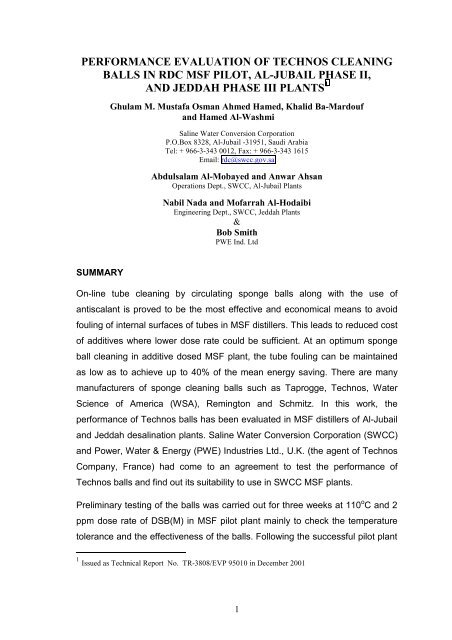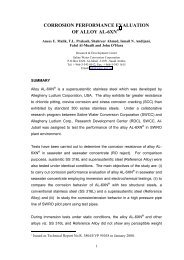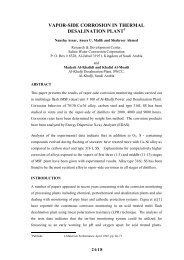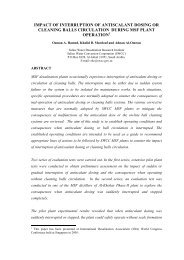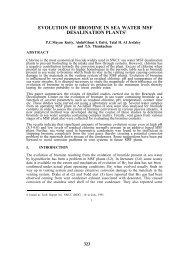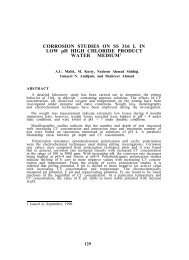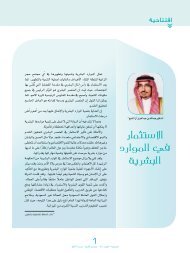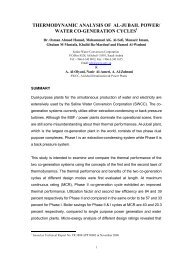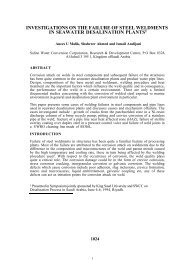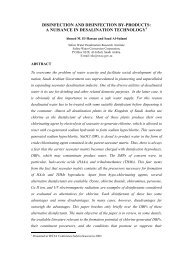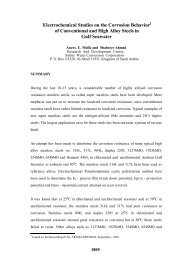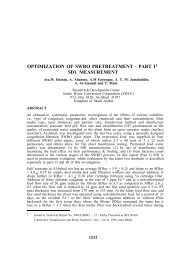performance evaluation of technos cleaning balls in rdc msf pilot
performance evaluation of technos cleaning balls in rdc msf pilot
performance evaluation of technos cleaning balls in rdc msf pilot
You also want an ePaper? Increase the reach of your titles
YUMPU automatically turns print PDFs into web optimized ePapers that Google loves.
PERFORMANCE EVALUATION OF TECHNOS CLEANING<br />
BALLS IN RDC MSF PILOT, AL-JUBAIL PHASE II,<br />
AND JEDDAH PHASE III PLANTS 1<br />
Ghulam M. Mustafa Osman Ahmed Hamed, Khalid Ba-Mardouf<br />
and Hamed Al-Washmi<br />
Sal<strong>in</strong>e Water Conversion Corporation<br />
P.O.Box 8328, Al-Jubail -31951, Saudi Arabia<br />
Tel: + 966-3-343 0012, Fax: + 966-3-343 1615<br />
Email: <strong>rdc</strong>@swcc.gov.sa<br />
Abdulsalam Al-Mobayed and Anwar Ahsan<br />
Operations Dept., SWCC, Al-Jubail Plants<br />
Nabil Nada and M<strong>of</strong>arrah Al-Hodaibi<br />
Eng<strong>in</strong>eer<strong>in</strong>g Dept., SWCC, Jeddah Plants<br />
&<br />
Bob Smith<br />
PWE Ind. Ltd<br />
SUMMARY<br />
On-l<strong>in</strong>e tube <strong>clean<strong>in</strong>g</strong> by circulat<strong>in</strong>g sponge <strong>balls</strong> along with the use <strong>of</strong><br />
antiscalant is proved to be the most effective and economical means to avoid<br />
foul<strong>in</strong>g <strong>of</strong> <strong>in</strong>ternal surfaces <strong>of</strong> tubes <strong>in</strong> MSF distillers. This leads to reduced cost<br />
<strong>of</strong> additives where lower dose rate could be sufficient. At an optimum sponge<br />
ball <strong>clean<strong>in</strong>g</strong> <strong>in</strong> additive dosed MSF plant, the tube foul<strong>in</strong>g can be ma<strong>in</strong>ta<strong>in</strong>ed<br />
as low as to achieve up to 40% <strong>of</strong> the mean energy sav<strong>in</strong>g. There are many<br />
manufacturers <strong>of</strong> sponge <strong>clean<strong>in</strong>g</strong> <strong>balls</strong> such as Taprogge, Technos, Water<br />
Science <strong>of</strong> America (WSA), Rem<strong>in</strong>gton and Schmitz. In this work, the<br />
<strong>performance</strong> <strong>of</strong> Technos <strong>balls</strong> has been evaluated <strong>in</strong> MSF distillers <strong>of</strong> Al-Jubail<br />
and Jeddah desal<strong>in</strong>ation plants. Sal<strong>in</strong>e Water Conversion Corporation (SWCC)<br />
and Power, Water & Energy (PWE) Industries Ltd., U.K. (the agent <strong>of</strong> Technos<br />
Company, France) had come to an agreement to test the <strong>performance</strong> <strong>of</strong><br />
Technos <strong>balls</strong> and f<strong>in</strong>d out its suitability to use <strong>in</strong> SWCC MSF plants.<br />
Prelim<strong>in</strong>ary test<strong>in</strong>g <strong>of</strong> the <strong>balls</strong> was carried out for three weeks at 110 o C and 2<br />
ppm dose rate <strong>of</strong> DSB(M) <strong>in</strong> MSF <strong>pilot</strong> plant ma<strong>in</strong>ly to check the temperature<br />
tolerance and the effectiveness <strong>of</strong> the <strong>balls</strong>. Follow<strong>in</strong>g the successful <strong>pilot</strong> plant<br />
1 Issued as Technical Report No. TR-3808/EVP 95010 <strong>in</strong> December 2001<br />
1
test<strong>in</strong>g, Technos <strong>balls</strong> were tested <strong>in</strong> Jeddah III Unit 9 for 4 weeks at a TBT <strong>of</strong><br />
107°C and <strong>in</strong> Al-Jubail II Unit 16 for 6 weeks at a TBT <strong>of</strong> 98°C. Heat transfer<br />
coefficients, foul<strong>in</strong>g factors, plant <strong>performance</strong>s and <strong>balls</strong> physical <strong>in</strong>tegrity<br />
were monitored dur<strong>in</strong>g the tests. The reduction <strong>in</strong> size <strong>of</strong> the <strong>balls</strong> due to<br />
normal wear and loss <strong>of</strong> <strong>balls</strong> <strong>in</strong> the system dur<strong>in</strong>g test period was found low<br />
and with<strong>in</strong> acceptable limits. The distiller <strong>performance</strong> and the <strong>in</strong>spection <strong>of</strong> the<br />
<strong>balls</strong> dur<strong>in</strong>g the tests at Jeddah and Al-Jubail plants showed that Technos <strong>balls</strong><br />
were effective and suitable for use <strong>in</strong> MSF distillers. It was therefore,<br />
recommended to place the product on approved bidders’ list for Al-Jubail<br />
Phase II and Jeddah Phase III Plants. Due to successful test <strong>of</strong> the Technos<br />
<strong>balls</strong>, it is also recommended to use and evaluate long-term <strong>performance</strong> <strong>of</strong><br />
Technos <strong>balls</strong> <strong>in</strong> other SWCC plants.<br />
1. INTRODUCTION<br />
Cleanl<strong>in</strong>ess <strong>of</strong> water side tube surfaces is a significant factor affect<strong>in</strong>g the heat transfer<br />
capacity <strong>of</strong> seawater/br<strong>in</strong>e cooled condensers <strong>in</strong> MSF distillation plants. Substances,<br />
which adhere to the heat transfer surface, decrease tube cleanl<strong>in</strong>ess and impede transfer<br />
<strong>of</strong> heat. These <strong>in</strong>clude precipitation foul<strong>in</strong>g or scal<strong>in</strong>g, biological foul<strong>in</strong>g and particulate<br />
foul<strong>in</strong>g. Though the formation <strong>of</strong> scale, which is the ma<strong>in</strong> source <strong>of</strong> foul<strong>in</strong>g <strong>in</strong> MSF<br />
distillers, is combated and controlled by threshold treatment us<strong>in</strong>g antiscalant, its<br />
complete prevention is impracticable. Sludge or distorted scale is also formed as a<br />
result <strong>of</strong> threshold treatment and gets deposited on tube metallic surfaces thus creates<br />
resistance to heat transfer. If not removed early after formation, these s<strong>of</strong>t deposits<br />
could convert <strong>in</strong>to solid scale. Sludge can be easily removed by employ<strong>in</strong>g on-l<strong>in</strong>e<br />
<strong>clean<strong>in</strong>g</strong> <strong>of</strong> the tubes. The comb<strong>in</strong>ed use <strong>of</strong> antiscalant and on-l<strong>in</strong>e tube <strong>clean<strong>in</strong>g</strong> has<br />
proved to be the most effective and economical means to avoid foul<strong>in</strong>g <strong>of</strong> <strong>in</strong>ternal<br />
surfaces <strong>of</strong> tubes. This leads to reduced cost <strong>of</strong> additives where lower dose rate could<br />
suffice. The most effective on-l<strong>in</strong>e tube <strong>clean<strong>in</strong>g</strong> system that is currently <strong>in</strong> use <strong>in</strong> MSF<br />
desal<strong>in</strong>ation plants is the sponge rubber ball circulation system. At an optimum sponge<br />
ball <strong>clean<strong>in</strong>g</strong> <strong>in</strong> additive dosed MSF plant, the tube foul<strong>in</strong>g can be ma<strong>in</strong>ta<strong>in</strong>ed as low as<br />
0.04 m 2 K/kW result<strong>in</strong>g <strong>in</strong> over 40% <strong>of</strong> the mean energy sav<strong>in</strong>g [1].<br />
2
There are many manufacturers <strong>of</strong> sponge <strong>clean<strong>in</strong>g</strong> <strong>balls</strong> such as Taprogge, Technos,<br />
Water Science <strong>of</strong> America (WSA), Rem<strong>in</strong>gton and Schimitz. They produce many types<br />
like polish<strong>in</strong>g, granulate, high temperature and corundum r<strong>in</strong>g or total coated sponge<br />
<strong>balls</strong>. Technos has developed a technique to blend the <strong>balls</strong> with the special materials<br />
that were previously used as coat<strong>in</strong>g on abrasive <strong>balls</strong>. The gra<strong>in</strong> size <strong>of</strong> the abrasive<br />
material is small enough to avoid the risk <strong>of</strong> scratch<strong>in</strong>g the tube metal surface, which<br />
could trigger erosion-corrosion phenomena. The technique is claimed to provide a<br />
major advantage over ball coat<strong>in</strong>g technique s<strong>in</strong>ce the desired abrasive effectiveness<br />
rema<strong>in</strong>s unchanged while the <strong>balls</strong> are be<strong>in</strong>g used [2].<br />
The scale/sludge removal ability <strong>of</strong> sponge rubber <strong>balls</strong> depends on many factors such<br />
as size, number, hardness, surface texture and age <strong>of</strong> the <strong>balls</strong>, the frequency and<br />
duration <strong>of</strong> treatment, and nature <strong>of</strong> metallic surface. Based on the operat<strong>in</strong>g<br />
experience, the average ball life <strong>in</strong> Al-Jubail Phase II Plant is 5-6 weeks with 8 cycles<br />
<strong>of</strong> ball circulation per shift while <strong>in</strong> Jeddah plant, it is 4 weeks with 6 cycles per shift.<br />
Al-S<strong>of</strong>i et al. reported from operational experiences that the number <strong>of</strong> <strong>balls</strong>, which can<br />
be fed to the system, could be as high as 60% <strong>of</strong> the number <strong>of</strong> tubes. He suggested that<br />
30% or even less would be adequate, yet much lower percentages be <strong>in</strong>sufficient to<br />
reach all the tubes while a higher percentage would lead to tube blockage, crowd<strong>in</strong>g at<br />
stra<strong>in</strong>er and accelerated wear at tube mouth [3]. The frequency and cycles <strong>of</strong> ball<br />
<strong>clean<strong>in</strong>g</strong> and ball to tube ratio used <strong>in</strong> SWCC MSF plants are reported by Dr. Hamed<br />
O.A. el al. [4] and are given <strong>in</strong> Annexure 1.<br />
In this project, for the first time Technos <strong>balls</strong> were evaluated at Research and<br />
Development Center (RDC) <strong>of</strong> SWCC by conduct<strong>in</strong>g test run at MSF <strong>pilot</strong> plant.<br />
Performance <strong>evaluation</strong> tests <strong>of</strong> Technos <strong>balls</strong> were further conducted <strong>in</strong> Jeddah III and<br />
Al-Jubail II commercial plants. Prelim<strong>in</strong>ary <strong>evaluation</strong> test <strong>of</strong> Technos <strong>balls</strong> <strong>in</strong> MSF<br />
<strong>pilot</strong> plant was conducted at a TBT <strong>of</strong> 110 o C and DSB(M) dose rate <strong>of</strong> 2 ppm over a<br />
test period <strong>of</strong> three weeks. After the successful test at <strong>pilot</strong> plant, <strong>balls</strong> were evaluated<br />
<strong>in</strong> Jeddah III Plant (Unit 9) at a TBT <strong>of</strong> 107°C and <strong>in</strong> Al-Jubail II Plant (Unit 16) at<br />
TBT <strong>of</strong> 98°C. Physical <strong>in</strong>tegrity <strong>of</strong> the <strong>balls</strong> such as mechanical damage, shr<strong>in</strong>kage,<br />
surface wear, deformation or loss <strong>of</strong> texture were monitored closely dur<strong>in</strong>g the tests <strong>in</strong><br />
both Jeddah and Al-Jubail plants. The effectiveness <strong>of</strong> <strong>balls</strong> <strong>in</strong> remov<strong>in</strong>g s<strong>of</strong>t scale and<br />
sludge was also checked by calculat<strong>in</strong>g heat transfer coefficients and foul<strong>in</strong>g factors.<br />
3
Visual <strong>in</strong>spections <strong>of</strong> heat transfer surfaces were also conducted after the tests. It was<br />
concluded that Technos <strong>balls</strong> had behaved satisfactorily and could be used <strong>in</strong><br />
commercial MSF plants.<br />
2. OBJECTIVE<br />
To evaluate the <strong>performance</strong> <strong>of</strong> the Technos <strong>clean<strong>in</strong>g</strong> <strong>balls</strong> <strong>in</strong> controll<strong>in</strong>g scale<br />
deposition <strong>in</strong> Al-Jubail phase II and Jeddah phase III desal<strong>in</strong>ation plants.<br />
3. EXPERIMENTAL METHODOLOGY<br />
3.1 Test Locations<br />
Tests were conducted <strong>in</strong> MSF <strong>pilot</strong>, Jeddah III and Al-Jubail II plants to study the<br />
<strong>performance</strong> <strong>of</strong> Technos <strong>balls</strong>. Brief description <strong>of</strong> the test plants is stated below.<br />
3.1.1 RDC Pilot Plant<br />
A 20 ton/day MSF <strong>pilot</strong> plant at RDC, Al-Jubail was used to give sufficient <strong>in</strong>dication<br />
<strong>of</strong> the <strong>performance</strong> <strong>of</strong> Technos <strong>balls</strong>. The <strong>pilot</strong> MSF unit consists <strong>of</strong> 4 stages <strong>in</strong> the heat<br />
recovery section and 2 stages <strong>in</strong> the heat rejection section. It has all important features<br />
<strong>of</strong> a fully established MSF commercial plant. Make-up seawater can be given additive<br />
and/or acid treatment <strong>in</strong>clusive <strong>of</strong> external deaerator and decarbonator. There is also a<br />
provision for acid <strong>clean<strong>in</strong>g</strong> <strong>of</strong> heat transfer tubes.<br />
3.1.2 Jeddah Plant Phase III<br />
Jeddah Phase III desal<strong>in</strong>ation and power plant is dual purpose plant designed to produce<br />
daily a total <strong>of</strong> 88,000 m 3 <strong>of</strong> potable water ( by four distillers) and 250 MW <strong>of</strong> electric<br />
power. The four MSF evaporators are <strong>of</strong> cross tube configuration and designed for<br />
maximum top br<strong>in</strong>e temperature <strong>of</strong> 107 o C. Each MSF desal<strong>in</strong>ation distiller has 14 heat<br />
recovery stages and 2 heat rejection stages. A separate deaerator is available to each<br />
unit. An on-l<strong>in</strong>e sponge ball <strong>clean<strong>in</strong>g</strong> system cleans the br<strong>in</strong>e heater and heat recovery<br />
tubes. Jeddah III br<strong>in</strong>e heater has a double pass tube design compared to the s<strong>in</strong>gle pass<br />
<strong>in</strong> all other SWCC commercial plants.<br />
4
3.1.3 Al-Jubail Plant Phase II<br />
Al-Jubail Phase II desal<strong>in</strong>ation and power plants are also dual purpose plants designed<br />
to produce daily 960,000 m 3 <strong>of</strong> potable water and 1300 MW <strong>of</strong> electric power. The<br />
MSF distillers are hav<strong>in</strong>g cross tube configuration and maximum top br<strong>in</strong>e temperature<br />
<strong>of</strong> 112.8 o C. The desal<strong>in</strong>ation unit where the test was carried out has 19 heat recovery<br />
stages and 3 heat rejection stages. Deaeration is carried out <strong>in</strong> a separate deaerator<br />
available with each unit. A sponge ball <strong>clean<strong>in</strong>g</strong> system is available for on-l<strong>in</strong>e <strong>clean<strong>in</strong>g</strong><br />
<strong>of</strong> br<strong>in</strong>e heater and heat recovery tubes.<br />
3.2 Test Materials<br />
Sponge <strong>balls</strong> were supplied by PWE Industries Ltd., while other chemicals required <strong>in</strong><br />
the operation <strong>of</strong> plants such as antiscalant, antifoam and sodium sulfite were provided<br />
by SWCC. The specifications <strong>of</strong> Technos <strong>balls</strong> are as follows:<br />
Type <strong>of</strong> sponge <strong>balls</strong> : High Temperature,<br />
Standard<br />
RDC Pilot Plant Jeddah III Plant Al-Jubail II Plant<br />
High Temperature,<br />
Standard<br />
High Temperature,<br />
Standard<br />
Hardness : Medium/Hard Medium/Hard Medium/Hard<br />
Ball diameter : 15 mm 29 mm 42 mm<br />
Temperature tolerance : 140 o C 140 o C 140 o C<br />
No. <strong>of</strong> <strong>balls</strong> required : 100 8000 2100<br />
3.3 Experimental Conditions<br />
The operat<strong>in</strong>g conditions <strong>of</strong> <strong>pilot</strong>, Jeddah III and Al-Jubail II plants are given <strong>in</strong> Table 1.<br />
3.4 Performance Evaluation Criteria<br />
Follow<strong>in</strong>g are the criteria for ball assessment.<br />
3.4.1 Ball Physical Integrity<br />
A fixed quantity <strong>of</strong> <strong>balls</strong> was charged <strong>in</strong> the evaporator. The <strong>balls</strong> were <strong>in</strong>spected daily<br />
for the first 3 days and thereafter twice a week to check the follow<strong>in</strong>g factors<br />
responsible for <strong>in</strong>effectiveness <strong>of</strong> the <strong>balls</strong>.<br />
5
3.4.1.1 Mechanical Damage<br />
Collision <strong>of</strong> <strong>balls</strong> with the flow path surfaces such as ball stra<strong>in</strong>er, tube bends and ends,<br />
water box walls and tube sheet are the most important factors responsible for ball<br />
splitt<strong>in</strong>g or damage. The repeated compression <strong>of</strong> the <strong>balls</strong> as they enter the tubes also<br />
leads to mechanical damage by erosion and peel<strong>in</strong>g.<br />
3.4.1.2 Shr<strong>in</strong>k<strong>in</strong>g<br />
Shr<strong>in</strong>k<strong>in</strong>g which makes ball <strong>in</strong>effective, is ma<strong>in</strong>ly attributed to the ball material and its<br />
temperature tolerance. Ball shr<strong>in</strong>k<strong>in</strong>g can be measured by its size and weight.<br />
3.4.1.3 Surface Wear<br />
Ball wear which occurs by abrasion due to tube roughness and also by the sludge and<br />
scale deposits <strong>in</strong> the tubes is a common phenomenon result<strong>in</strong>g <strong>in</strong> loss <strong>of</strong> ball<br />
effectiveness. The phenomenon is related to the ball material and tube surface<br />
conditions. Any uneven or accelerated wear <strong>of</strong> the <strong>balls</strong> was carefully exam<strong>in</strong>ed dur<strong>in</strong>g<br />
the test runs. Perforated screens were used to estimate reduction <strong>in</strong> size <strong>of</strong> <strong>balls</strong>.<br />
3.4.1.4 Deformation<br />
Any deformation <strong>in</strong> the shape <strong>of</strong> the <strong>balls</strong> (e.g., shape change to cyl<strong>in</strong>drical) results <strong>in</strong><br />
uneven tube <strong>clean<strong>in</strong>g</strong>. The deformation is ma<strong>in</strong>ly related to the temperature and<br />
pressure tolerance <strong>of</strong> the <strong>balls</strong>’ materials. Cyl<strong>in</strong>drical shape <strong>of</strong> the <strong>balls</strong> may result due<br />
to deformation or due to constant wear <strong>of</strong> the <strong>balls</strong> <strong>in</strong> one direction. The wear and<br />
deformation can be differentiated by the length and weight <strong>of</strong> the cyl<strong>in</strong>drical <strong>balls</strong>.<br />
3.4.1.5 Loss <strong>of</strong> Texture<br />
Loss <strong>of</strong> texture is a major deficiency <strong>of</strong> <strong>balls</strong> that restricts the ability <strong>of</strong> <strong>balls</strong> to rega<strong>in</strong><br />
their shape and size. It also results <strong>in</strong> sticky <strong>balls</strong>. Ball material should be good enough<br />
to withstand high temperature and prolonged contact with seawater.<br />
3.4.2 Thermal Performance<br />
The heat transfer coefficient and foul<strong>in</strong>g factor data which relate directly to the <strong>in</strong>crease<br />
<strong>of</strong> heat transfer resistance by scal<strong>in</strong>g are plotted with time to evaluate the effectiveness<br />
<strong>of</strong> the sponge <strong>balls</strong> <strong>in</strong> keep<strong>in</strong>g the heat transfer surfaces clean. Chemical dose rate and<br />
6
all <strong>clean<strong>in</strong>g</strong> frequency were kept same as <strong>in</strong> normal operation and test data were<br />
recorded.<br />
It is preferred to <strong>in</strong>spect visually the tubes and water-boxes <strong>of</strong> br<strong>in</strong>e heater and high<br />
temperature stages before and after the test to check the extent <strong>of</strong> scale and sludge<br />
deposition. It provides <strong>in</strong>formation about the effective distribution or s<strong>in</strong>k<strong>in</strong>g rate <strong>of</strong> the<br />
<strong>balls</strong>. However, the <strong>in</strong>spection <strong>of</strong> the commercial distillers is bound to the ma<strong>in</strong>tenance<br />
schedule and high demand <strong>of</strong> water production.<br />
3.4.3 Chemical Analyses<br />
Chemical analyses <strong>of</strong> different br<strong>in</strong>e streams were performed daily to monitor the<br />
constituents responsible for steady operation <strong>of</strong> the plants. The analyses <strong>of</strong> copper<br />
content <strong>in</strong> the br<strong>in</strong>e recycle and br<strong>in</strong>e blowdown streams were also done to f<strong>in</strong>d out the<br />
extent <strong>of</strong> tube metal losses due to ball <strong>clean<strong>in</strong>g</strong>.<br />
4. RESULTS AND DISCUSSION<br />
Dur<strong>in</strong>g the tests <strong>of</strong> Technos <strong>balls</strong> <strong>in</strong> MSF <strong>pilot</strong>, Jeddah III and Al-Jubail II commercial<br />
plants, operations <strong>in</strong>clud<strong>in</strong>g ball <strong>performance</strong> were monitored closely.<br />
4.1 MSF Pilot Plant<br />
Prior to the tests on commercial plants, a test on the RDC <strong>pilot</strong> plant was carried out to<br />
make a prelim<strong>in</strong>ary assessment about the temperature tolerance and effectiveness <strong>of</strong> the<br />
Technos <strong>balls</strong>. Balls were tested at 110 o C for one-week duration and the <strong>performance</strong><br />
was compared with that <strong>of</strong> the <strong>balls</strong> presently under use <strong>in</strong> the plant.<br />
4.1.1 Ball Physical Integrity<br />
Technos <strong>balls</strong> were checked for any mechanical damage, shr<strong>in</strong>kage, surface wear,<br />
deformation or loss <strong>of</strong> texture periodically dur<strong>in</strong>g execution <strong>of</strong> the test. Balls were not<br />
found to undergo any sort <strong>of</strong> deformation, texture failure or any type <strong>of</strong> mechanical<br />
damage dur<strong>in</strong>g the test. The used <strong>balls</strong> were not found s<strong>of</strong>ter than the new ones. The<br />
diameter <strong>of</strong> used <strong>balls</strong> was also around 14.5 mm. A little decrease <strong>in</strong> size (i.e. ∼0.5 mm)<br />
was attributed to the shr<strong>in</strong>kage and uniform wear.<br />
7
4.1.2 Thermal Performance<br />
Overall heat transfer coefficients (OHTC) and foul<strong>in</strong>g factors are calculated and plotted<br />
with time to evaluate the effectiveness <strong>of</strong> sponge <strong>balls</strong> <strong>in</strong> keep<strong>in</strong>g heat transfer surfaces<br />
clean as shown <strong>in</strong> Figures 1. OHTC <strong>of</strong> br<strong>in</strong>e heater tubes dur<strong>in</strong>g test period fluctuated<br />
between 4 to 4.8 kW/m 2 K, while foul<strong>in</strong>g factors varied between 0.01 to 0.06 m 2 K/kW.<br />
These values are found to be acceptable and quite match<strong>in</strong>g with those normally<br />
encountered dur<strong>in</strong>g earlier operations (us<strong>in</strong>g other type <strong>of</strong> <strong>balls</strong>).<br />
Tubes, tube sheets and water boxes <strong>of</strong> br<strong>in</strong>e heater were <strong>in</strong>spected visually before and<br />
after the test. In pre-test <strong>in</strong>spection after <strong>clean<strong>in</strong>g</strong> by acid operation, the br<strong>in</strong>e heater<br />
tubes and tube sheets were found clean. Post-test <strong>in</strong>spection revealed that there was<br />
some s<strong>of</strong>t scale (sludge) deposits on tube sheets. However, tubes were mostly free from<br />
scale. Deposition <strong>of</strong> sludge on tube sheet can be attributed to high sludg<strong>in</strong>g<br />
characteristic <strong>of</strong> DSB(M) at a dose rate <strong>of</strong> 2 ppm.<br />
4.1.3 Chemical Analysis<br />
The results <strong>of</strong> the chemical analysis, which <strong>in</strong>cluded the copper contents, and alkal<strong>in</strong>ity<br />
<strong>of</strong> various br<strong>in</strong>e streams <strong>in</strong> MSF <strong>pilot</strong> plant, were found with<strong>in</strong> acceptable limits.<br />
4.2 Jeddah III Commercial Plant<br />
Test was carried out <strong>in</strong> unit 9 <strong>of</strong> Jeddah III Plant for duration <strong>of</strong> 4 weeks. Prior to the<br />
test run, the distiller was cleaned by cont<strong>in</strong>uous acid operation for duration <strong>of</strong> two<br />
weeks. The m<strong>in</strong>utes <strong>of</strong> the meet<strong>in</strong>g conducted before and after the tests are given <strong>in</strong><br />
Annexure 1.<br />
4.2.1 Ball Physical Integrity<br />
Physical <strong>in</strong>tegrity <strong>of</strong> Technos <strong>balls</strong> dur<strong>in</strong>g a test period <strong>of</strong> four weeks was closely<br />
exam<strong>in</strong>ed and their conditions are reported <strong>in</strong> Table 2. Balls were not found to have<br />
undergone any breakage, shr<strong>in</strong>kage or loss <strong>of</strong> texture. However, their roundness were<br />
lost primarily due to wear which was found to be quite uneven. The extent <strong>of</strong> wear<br />
caus<strong>in</strong>g deformation <strong>of</strong> Technos <strong>balls</strong> was found to be with<strong>in</strong> acceptable limits <strong>of</strong> a<br />
normal ball <strong>clean<strong>in</strong>g</strong> phenomenon. Figure 2 shows the deformed used <strong>balls</strong> and unused<br />
<strong>balls</strong>. Used <strong>balls</strong> are deformed <strong>in</strong> cyl<strong>in</strong>drical shape. It is primarily due to the fact that<br />
8
alls once received certa<strong>in</strong> wear <strong>in</strong> a particular orientation, keep themselves along the<br />
same axis (due to less resistance) every time they go through a tube.<br />
The consumption <strong>of</strong> the <strong>balls</strong> with time was also <strong>in</strong>vestigated and found that the rate <strong>of</strong><br />
<strong>balls</strong> replacement due to wear and tear was with<strong>in</strong> acceptable limits. Balls started<br />
becom<strong>in</strong>g under-sized after 15 days <strong>of</strong> operation and on completion <strong>of</strong> 30 days <strong>of</strong><br />
operation, 1461 <strong>balls</strong> out <strong>of</strong> the total charge <strong>of</strong> 1600 were found under-sized. The ball<br />
lifetime, however, depends ma<strong>in</strong>ly on distiller size, its configuration and frequency <strong>of</strong><br />
ball <strong>clean<strong>in</strong>g</strong> for a particular ball type. The number <strong>of</strong> <strong>balls</strong> rejected due to under-size <strong>in</strong><br />
each <strong>in</strong>spection is shown <strong>in</strong> Figure 3, while cumulative counts <strong>of</strong> <strong>balls</strong> damaged and<br />
lost with time are plotted <strong>in</strong> Figure 4.<br />
4.2.2 Thermal Performance<br />
The plant <strong>performance</strong> and the br<strong>in</strong>e heater foul<strong>in</strong>g were exam<strong>in</strong>ed dur<strong>in</strong>g the test<br />
period. The plant was unstable dur<strong>in</strong>g the period <strong>of</strong> 50 to 150 hours <strong>of</strong> the test. Figure 5<br />
shows the <strong>performance</strong> <strong>of</strong> the distiller dur<strong>in</strong>g the test period <strong>in</strong>clud<strong>in</strong>g the trends <strong>of</strong><br />
foul<strong>in</strong>g factor and heat transfer coefficient <strong>in</strong> br<strong>in</strong>e heater. Foul<strong>in</strong>g factor fluctuated <strong>in</strong><br />
the range <strong>of</strong> 0.1 to 0.32 m 2 K/kW but most <strong>of</strong> the time rema<strong>in</strong>ed with<strong>in</strong> 0.2 m 2 K/kW,<br />
which is lower than the design service-foul<strong>in</strong>g factor <strong>of</strong> 0.325 m 2 K/kW <strong>in</strong>dicat<strong>in</strong>g the<br />
effectiveness <strong>of</strong> ball <strong>clean<strong>in</strong>g</strong> system. Steady trend <strong>of</strong> foul<strong>in</strong>g factor <strong>in</strong>dicates positive<br />
<strong>performance</strong> <strong>of</strong> Technos <strong>balls</strong>.<br />
Trends <strong>of</strong> ga<strong>in</strong> output ratio (GOR) and <strong>performance</strong> ratio (PR) dur<strong>in</strong>g the test period<br />
revealed that plant <strong>performance</strong> was constant and thus Technos <strong>balls</strong> were effective <strong>in</strong><br />
ma<strong>in</strong>ta<strong>in</strong><strong>in</strong>g the heat transfer surfaces free from any additional scale deposition.<br />
4.2.3 Chemical Analysis<br />
Chemical analyses <strong>of</strong> various br<strong>in</strong>e streams <strong>in</strong> distiller # 9 were carried out daily for<br />
pH, M-alkal<strong>in</strong>ity and chloride contents. These values were found with<strong>in</strong> acceptable<br />
limits. Loss <strong>of</strong> total alkal<strong>in</strong>ity (LTA) and concentration ratio were calculated <strong>in</strong> streams<br />
<strong>of</strong> br<strong>in</strong>e recycle and br<strong>in</strong>e blowdown. Figure 6 shows LTA, M-alkal<strong>in</strong>ity, concentration<br />
ratio and copper content <strong>of</strong> br<strong>in</strong>e blowdown. Cu contents <strong>in</strong> the stream <strong>of</strong> br<strong>in</strong>e<br />
blowdown before and dur<strong>in</strong>g ball <strong>clean<strong>in</strong>g</strong> were found fluctuat<strong>in</strong>g between 7 and 23<br />
ppb, which is with<strong>in</strong> normal limit <strong>of</strong> the Cu content found dur<strong>in</strong>g normal operation.<br />
9
4.3 Al-Jubail II Commercial Plant<br />
First batch <strong>of</strong> Technos <strong>balls</strong> were tested <strong>in</strong> Units #8 & #15 <strong>of</strong> Al-Jubail II plant. The<br />
tests failed due to low-ball recovery (from the system) and abnormal deformation (hard<br />
material projection) <strong>of</strong> the <strong>balls</strong>. For the first time, the company had produced the <strong>balls</strong><br />
<strong>of</strong> 42 mm size and the deformation was due to the manufactur<strong>in</strong>g defect. The matter<br />
was conveyed to the manufacturer who sent a new batch <strong>of</strong> modified Technos <strong>balls</strong> for<br />
further tests <strong>in</strong> Al-Jubail Unit #16. The test was successful and new Technos <strong>balls</strong> were<br />
proved to be suitable for use <strong>in</strong> Al-Jubail desal<strong>in</strong>ation plant.<br />
4.3.1 Balls Physical Integrity<br />
Dur<strong>in</strong>g test <strong>in</strong> Unit # 16 <strong>of</strong> Al-Jubail II desal<strong>in</strong>ation plant, visual <strong>in</strong>spection <strong>of</strong> Technos<br />
<strong>balls</strong> were carried out daily for any mechanical damage, shr<strong>in</strong>kage, surface wear,<br />
deformation or loss <strong>of</strong> texture. The number <strong>of</strong> <strong>balls</strong> fed, damaged and lost <strong>in</strong> the system<br />
dur<strong>in</strong>g each <strong>in</strong>spection are presented <strong>in</strong> Table 3. Dur<strong>in</strong>g test period, <strong>balls</strong> were not<br />
found to undergo any sort <strong>of</strong> deformation, shr<strong>in</strong>kage, texture failure or mechanical<br />
damage. The roundness <strong>of</strong> <strong>balls</strong> was also ma<strong>in</strong>ta<strong>in</strong>ed. The wear caus<strong>in</strong>g deformation <strong>of</strong><br />
<strong>balls</strong> was found negligible even after six weeks <strong>of</strong> test duration. The consumption <strong>of</strong><br />
<strong>balls</strong> was only due to their loss <strong>in</strong> the system, which is plotted <strong>in</strong> Figure 7.<br />
The rate <strong>of</strong> reduction <strong>in</strong> size <strong>of</strong> the <strong>balls</strong> due to normal wear dur<strong>in</strong>g test period was very<br />
low and much below the acceptable limit <strong>of</strong> normal ball wear dur<strong>in</strong>g ball <strong>clean<strong>in</strong>g</strong><br />
process (Figure 8). It shows the satisfactory <strong>performance</strong> <strong>of</strong> the Technos <strong>balls</strong>. Dur<strong>in</strong>g<br />
more than 6 weeks <strong>of</strong> test duration, the average ball size was around 41 mm, which is<br />
much above the m<strong>in</strong>imum acceptable limit <strong>of</strong> 39 mm (recommended size for ball<br />
replacement). No ball was rejected because <strong>of</strong> undersize dur<strong>in</strong>g the test period.<br />
4.3.2 Thermal Performance<br />
The plant <strong>performance</strong> was monitored closely dur<strong>in</strong>g the test period. Figure 9 shows the<br />
variation <strong>of</strong> foul<strong>in</strong>g factor and heat transfer coefficient <strong>in</strong> br<strong>in</strong>e heater and also the trend<br />
<strong>of</strong> flash range, water production and plant <strong>performance</strong>. Foul<strong>in</strong>g factor fluctuated <strong>in</strong> the<br />
range <strong>of</strong> 0.1 to 0.2 m 2 K/kW while HTC varied <strong>in</strong> the range <strong>of</strong> 2.6 to 3.4 kW/m 2 K,<br />
which is higher than the design HTC <strong>of</strong> 2.26 kW/m 2 K <strong>in</strong>dicat<strong>in</strong>g the effectiveness <strong>of</strong><br />
10
all <strong>clean<strong>in</strong>g</strong> system. The high fluctuation <strong>in</strong> foul<strong>in</strong>g factor is due to <strong>in</strong>stability <strong>of</strong><br />
operat<strong>in</strong>g parameters particularly flash range.<br />
Performance ratio (PR) and ga<strong>in</strong> output ratio (GOR) were calculated and they were<br />
found steady. Figure 9 shows the trends <strong>of</strong> PR and GOR dur<strong>in</strong>g the test period. GOR<br />
varied from 7.6 to 8.2, which revealed that the plant <strong>performance</strong> was almost uniform<br />
and thus Technos <strong>balls</strong> were effective <strong>in</strong> ma<strong>in</strong>ta<strong>in</strong><strong>in</strong>g the heat transfer surfaces free<br />
from any additional scale deposition.<br />
4.3.3 Chemical Analysis<br />
Chemical analyses <strong>of</strong> various br<strong>in</strong>e streams <strong>in</strong> distiller # 16 were carried out daily for<br />
pH, M-alkal<strong>in</strong>ity and chloride and found with<strong>in</strong> acceptable limits. Cu content <strong>in</strong> br<strong>in</strong>e<br />
blowdown stream dur<strong>in</strong>g test period was also analyzed and found with<strong>in</strong> the range <strong>of</strong><br />
Cu content dur<strong>in</strong>g normal operation. Figure 10 shows loss <strong>of</strong> total alkal<strong>in</strong>ity and<br />
concentration ratio <strong>in</strong> streams <strong>of</strong> br<strong>in</strong>e recycle.<br />
5. CONCLUSIONS<br />
Based on the above, the follow<strong>in</strong>g conclusions are drawn:<br />
(a)<br />
(b)<br />
(c)<br />
(d)<br />
No significant mechanical damage, shr<strong>in</strong>kage, abnormal deformation or loss <strong>of</strong><br />
texture was found <strong>in</strong> Technos <strong>balls</strong> dur<strong>in</strong>g tests at <strong>pilot</strong>, Jeddah III and Al-Jubail<br />
II plants.<br />
Decrease <strong>in</strong> <strong>balls</strong> size or loss <strong>of</strong> their roundness dur<strong>in</strong>g these tests was found<br />
with<strong>in</strong> acceptable limit, typically experienced <strong>in</strong> normal operation.<br />
The consumption <strong>of</strong> the <strong>balls</strong> with time or the rate <strong>of</strong> <strong>balls</strong> replacement due to ball<br />
undersize or deformation was found low and with<strong>in</strong> acceptable limit.<br />
Technos ball <strong>clean<strong>in</strong>g</strong> was found effective <strong>in</strong> controll<strong>in</strong>g scale deposition <strong>in</strong> tubes<br />
dur<strong>in</strong>g tests conducted <strong>in</strong> MSF <strong>pilot</strong> plant <strong>of</strong> RDC and SWCC MSF distillers <strong>of</strong><br />
Al-Jubail II and Jeddah III plants.<br />
11
6. RECOMMENDATIONS<br />
(a) In view <strong>of</strong> the satisfactory <strong>performance</strong> <strong>of</strong> Technos <strong>balls</strong> <strong>in</strong> controll<strong>in</strong>g scale<br />
deposition <strong>in</strong> heat transfer tubes and ma<strong>in</strong>ta<strong>in</strong><strong>in</strong>g plant <strong>performance</strong> dur<strong>in</strong>g four<br />
weeks <strong>of</strong> operation <strong>in</strong> Jeddah III plant at a TBT <strong>of</strong> 107 o C and six weeks <strong>in</strong> Al-<br />
Jubail II plant at TBT <strong>of</strong> 98 o C, it is recommended to place the product on<br />
approved bidders list for Al-Jubail Phase II and Jeddah Phase III plants.<br />
(b) Due to successful tests and excellent <strong>performance</strong> <strong>of</strong> the Technos <strong>balls</strong> <strong>in</strong> the<br />
above plants, it is recommended to use and evaluate Technos <strong>balls</strong> <strong>in</strong> other SWCC<br />
plants.<br />
12
Table 1. Operat<strong>in</strong>g Conditions for Trial Tests <strong>of</strong> Technos Clean<strong>in</strong>g Balls<br />
Test location<br />
M<strong>in</strong>imum<br />
Duration<br />
TBT<br />
Conc. Ratio<br />
(BR)<br />
Type <strong>of</strong><br />
Antiscalant<br />
Dose Rate <strong>of</strong><br />
Antiscalant<br />
Sponge Balls Ball<br />
Clean<strong>in</strong>g<br />
Frequency<br />
No. <strong>of</strong><br />
Balls/Charge<br />
Test #1 :<br />
3 Weeks<br />
110 o C 1.4 DSB (M) 2 ppm Technos 6 cycles/<br />
5<br />
RDC MSF Pilot<br />
Plant<br />
(Nov. 2 to<br />
Nov. 23, 1998)<br />
8 hours<br />
Test #2 :<br />
4 Weeks<br />
107 ∼1.4 DSB (M) 3 ppm Technos 6 cycles/<br />
1600<br />
Jeddah III plant,<br />
(Unit 9)<br />
(Feb.22 to<br />
Mar. 23, 1999)<br />
8 hours<br />
Test #3:<br />
6 Weeks<br />
98 1.4 Belgard<br />
1 ppm Technos 8 cycles/<br />
500<br />
Al-Jubail II Plant,<br />
(Unit 16)<br />
(Sept.1 to<br />
Oct.14, 2001)<br />
EV 2030<br />
8 hours<br />
13
Table 2. Technos Balls Inspection Report for Jeddah III Plant (Unit 9)<br />
Balls Type : Technos<br />
Start<strong>in</strong>g Date : 22.2.99, 10:00 hr<br />
S. Total<br />
No. Inspection <strong>balls</strong> Charged<br />
Date &Time<br />
No. <strong>of</strong> Balls Recovered<br />
Good<br />
Damaged<br />
No. <strong>of</strong> Balls Lost<br />
<strong>in</strong> the System<br />
No. <strong>of</strong> New<br />
Balls Used<br />
Type <strong>of</strong> Damage <strong>of</strong> Balls<br />
Break Shr<strong>in</strong>k Wear Deform<br />
Cum. Cum. Cum. Remarks<br />
1. 22.2.99, 10:00 1600 - - - - - - -<br />
2. 23.2.99, 09:20 1591 1591 - - 9 9 - -<br />
3. 24.2.99, 09:00 1590 1590 - - 1 10 - -<br />
4. 27.2.99, 10:00 1580 1580 - - 10 20 - -<br />
5. 28.2.99, 10:00 1563 1563 - - 17 37 - -<br />
6. 1.3.99, 14:00 1630 1530 - - 33 70 100 100<br />
7. 3.3.99, 08:30 1630 1630 - - 0 70 - 100<br />
8. 6.3.99, 08:30 1620 1620 - - 10 80 - 100<br />
9. 8.3.99, 08:30 1590 1590 - - 30 110 - 100 √ √<br />
10. 10.3.99, 08:30 1553 1153 400 400 37 147 400 500 √ √<br />
11. 13.3.99, 09:30 1590 1090 500 900 -37 110 500 1000 √ √<br />
12. 15.3.99, 09:30 1590 1390 200 1100 - 110 200 1200 √ √<br />
13. 17.3.99, 09:00 1590 1290 300 1400 - 110 300 1500 √ √<br />
14. 21.3.99, 09:00 - 1530 60 1460 - 110 - 1560<br />
Texture<br />
14
Table 3. Technos Balls Inspection Report for Al-Jubail II Plant (Unit 16)<br />
Balls Type : Technos<br />
Start<strong>in</strong>g Date : 01.09.2001, 10:00 hr<br />
S. Total<br />
No. Inspection Balls Charged<br />
Date &Time<br />
No. <strong>of</strong> Balls Recovered<br />
Type <strong>of</strong> Damage <strong>of</strong> Balls<br />
No. <strong>of</strong> Balls Lost No. <strong>of</strong> New<br />
<strong>in</strong> the System Balls Used<br />
Good Damaged<br />
Break Shr<strong>in</strong>k Wear Deform Texture<br />
Cum. Cum. Cum. Remarks<br />
1. 1-Sep-01 500 - - 0 0 0 - -<br />
2. 3-Sep-01 374 374 - 0 126 126 - -<br />
3. 5-Sep-01 344 344 - 0 30 156 - -<br />
4. 7-Sep-01 450 367 2 2 -25 131 83 83 √<br />
5. 10-Sep-01 365 365 - 2 85 216 - 83<br />
6. 15-Sep-01 404 404 - 2 -39 177 - 83<br />
7. 23-Sep-01 435 435 - 2 -31 146 - 83<br />
8. 30-Sep-01 459 459 - 2 -24 122 - 83<br />
9. 7-Oct-01 453 453 - 2 6 128 - 83<br />
10 13-Oct-01 - 446 - 2 7 135 - 83<br />
15
10<br />
0.5<br />
Heat Transfer Coefficient,<br />
kW/m 2 .K<br />
8<br />
6<br />
4<br />
2<br />
HTC Design Value = 2.491<br />
Foul<strong>in</strong>g Factor<br />
Heat Transfer Coefficient<br />
Design FF = 0.176<br />
0.4<br />
0.3<br />
0.2<br />
0.1<br />
Foul<strong>in</strong>g Factor, m m 2 2 .K/kW<br />
0<br />
0 100 200 300 400 500 600<br />
Test Duration <strong>in</strong> Hours<br />
0<br />
Figure 1. Trends <strong>of</strong> Heat Transfer Coefficients and Foul<strong>in</strong>g Factors<br />
<strong>in</strong> Br<strong>in</strong>e Heater <strong>of</strong> MSF Pilot Plant<br />
Used Technos Balls<br />
New Technos Balls<br />
Figure 2. Photograph <strong>of</strong> Used and New Technos Balls <strong>of</strong> 29 mm Diameter<br />
for Jeddah III Plant (Unit 9)
2000<br />
Number <strong>of</strong> Damaged Balls<br />
1500<br />
1000<br />
500<br />
400<br />
500<br />
200<br />
300<br />
1460<br />
60<br />
0<br />
10.2.99 10.3.99 13.3.99 15.3.99 17.3.99 21.3.99<br />
Total Damaged Balls<br />
Inspection Date<br />
Figure 3. Physical Performance <strong>of</strong> Technos Balls <strong>in</strong> Jeddah III Plant<br />
(Unit 9)<br />
Number <strong>of</strong> Balls<br />
2000<br />
1500<br />
1000<br />
500<br />
Cum. Damaged Balls<br />
Cum. Lost Balls<br />
0<br />
0 100 200 300 400 500 600 700<br />
Test Duration <strong>in</strong> Hours<br />
Figure 4. Consumption Trends <strong>of</strong> Technos Balls Dur<strong>in</strong>g Test Period <strong>in</strong><br />
Jeddah III Plant (Unit 9)<br />
17
Heat Transfer<br />
Coefficient, kW/m 2 K<br />
5<br />
4<br />
3<br />
2<br />
1<br />
0<br />
Heat Transfer Coefficient <strong>in</strong> Br<strong>in</strong>e Heater<br />
Foul<strong>in</strong>g Factor <strong>in</strong> Br<strong>in</strong>e Heater<br />
Foul<strong>in</strong>g Factor Design Value = 0.325<br />
1.0<br />
0.8<br />
0.6<br />
0.4<br />
0.2<br />
0.0<br />
Foul<strong>in</strong>g Factor,<br />
m 2 K/kW<br />
80<br />
Flash Range, o C<br />
75<br />
70<br />
65<br />
60<br />
Distillate, m 3 /hr<br />
1200<br />
1100<br />
1000<br />
900<br />
800<br />
9<br />
Product Water Flow<br />
Condensate Flow<br />
200<br />
150<br />
100<br />
50<br />
0<br />
Condensate , m 3 /hr<br />
Plant Performance<br />
Ga<strong>in</strong> Output Ratio, (kg Water/kg Condensate)<br />
8<br />
Performance Ratio, (kg Water/2326kJ Steam)<br />
7<br />
Design PR Value = 7.09<br />
6<br />
5<br />
0 100 200 300 400 500 600 700 800<br />
Test Duration <strong>in</strong> Hours<br />
Figure 5. Plant Performance Dur<strong>in</strong>g Test <strong>of</strong> Technos Balls <strong>in</strong> Jeddah III<br />
Plant (Unit 9)<br />
18
pH LTA<br />
2.00<br />
9<br />
1.00<br />
8.9<br />
0.00<br />
8.8<br />
-1.00<br />
8.7<br />
-2.00<br />
8.6<br />
-3.00<br />
8.5<br />
200<br />
pH - BRP<br />
pH - BBD<br />
Copper Content, ppb Conc. Ratio<br />
M. Alkal<strong>in</strong>ity, ppm<br />
190<br />
180<br />
170<br />
160<br />
150<br />
2<br />
1.8<br />
1.6<br />
1.4<br />
1.2<br />
1<br />
30<br />
25<br />
20<br />
15<br />
10<br />
5<br />
0<br />
Copper - BBD (Before Ball Clean<strong>in</strong>g)<br />
Copper - BBD (Dur<strong>in</strong>g Ball Clean<strong>in</strong>g)<br />
Alkal<strong>in</strong>ity - BRP<br />
Alkal<strong>in</strong>ity - BBD<br />
CR - BR<br />
CR - BD<br />
0 100 200 300 400 500 600 700 800<br />
Test Duration <strong>in</strong> Hours<br />
Figure 6.<br />
Chemical Analysis Dur<strong>in</strong>g Performance Test <strong>of</strong> Technos<br />
Balls <strong>in</strong> Jeddah III Plant (Unit-9)<br />
19
700<br />
600<br />
500<br />
Lost Balls <strong>in</strong> Each Inspection<br />
Cum. Lost Balls<br />
Total Balls <strong>in</strong> System<br />
500 500 500<br />
583 583 583 583 583 583<br />
Number <strong>of</strong> Balls<br />
400<br />
300<br />
200<br />
100<br />
0<br />
-100<br />
216<br />
177<br />
156<br />
146<br />
126 131<br />
122 128 135<br />
85<br />
30<br />
6 7<br />
-25<br />
-39<br />
-31 -24<br />
1-Sep-01<br />
3-Sep 5-Sep 7-Sep 10-Sep 15-Sep 23-Sep 30-Sep 7-Oct 13-Oct -01<br />
Inspection Date<br />
Figure 7. Performance <strong>of</strong> Technos Balls <strong>in</strong> Al-Jubail II Plant<br />
(Unit 16)<br />
44<br />
Average Ball Size, mm<br />
43<br />
42<br />
41<br />
40<br />
Average Size <strong>of</strong> New Balls = 42.5 mm<br />
M<strong>in</strong>imum acceptable limit <strong>of</strong> <strong>balls</strong> size = 39.5 mm<br />
39<br />
0 100 200 300 400 500 600 700 800 900 1000 1100<br />
Test Duration <strong>in</strong> Hours<br />
Figure 8 . Trend <strong>of</strong> Average Ball Size <strong>of</strong> Technos Balls Dur<strong>in</strong>g Test<br />
<strong>in</strong> Al-Jubail II Plant (Unit 16)<br />
20
Heat Transfer<br />
Heat Transfer Coeff.,<br />
Coefficient, kW /m kW/m 2 K<br />
2 o C<br />
10<br />
8<br />
6<br />
4<br />
2<br />
0<br />
70<br />
Heat Transfer Heat Transfer Coefficient Coefficient <strong>in</strong> Br<strong>in</strong>e Heater<br />
Foul<strong>in</strong>g Factor<br />
Foul<strong>in</strong>g Factor <strong>in</strong> Br<strong>in</strong>e Heater<br />
Design HTC Value = 2.258<br />
0.5<br />
0.4<br />
0.3<br />
0.2<br />
0.1<br />
0<br />
Foul<strong>in</strong>g Foul<strong>in</strong>g Factor, m 2 2o K/kW C/kW<br />
Flash Range, o C<br />
65<br />
60<br />
55<br />
Water Production, m 3 /hr<br />
50<br />
1400<br />
1300<br />
1200<br />
1100<br />
1000<br />
Product Water Flow<br />
Condensate Flow<br />
200<br />
150<br />
100<br />
50<br />
0<br />
Condensate Flow, m 3 /hr<br />
Plant Performance<br />
11<br />
Ga<strong>in</strong> Output Ratio, (kg Water/kg Condensate)<br />
Performance Ratio, (kg Water/2326kJ Steam)<br />
9<br />
7<br />
5<br />
0 200 400 600 800 1000 1200<br />
Test Duration <strong>in</strong> Hours<br />
Test Duration <strong>in</strong> Hours<br />
Figure 9. Plant Performance Dur<strong>in</strong>g Test <strong>of</strong> Technos Balls <strong>in</strong> Al-Jubail II<br />
Plant (Unit 16)<br />
21
4<br />
3<br />
CR (BR/SW)<br />
LTA<br />
CR & LTA<br />
2<br />
1<br />
0<br />
0 200 400 600 800 1000 1200<br />
Test Duration <strong>in</strong> Hours<br />
Figure 10.<br />
Chemical Analysis Dur<strong>in</strong>g Performance Test <strong>of</strong> Technos<br />
Balls <strong>in</strong> Al-Jubail II Plant (Unit 16)<br />
22
REFERENCES<br />
1. Bohmer, H., (1993), On-load Tube Clean<strong>in</strong>g Systems and Debris Filters for<br />
Avoidance <strong>of</strong> Micro- and Macro-Foul<strong>in</strong>g <strong>in</strong> MSF Desal<strong>in</strong>ation Plants, Desal<strong>in</strong>ation,<br />
93, 171.<br />
2. Al-Bakeri, F. and El Hares, H., (1993), Optimization <strong>of</strong> Sponge Ball Clean<strong>in</strong>g<br />
System Operation and Design <strong>in</strong> MSF Plants, Desal<strong>in</strong>ation , 92, 353-375.<br />
3. Al-S<strong>of</strong>i, M. A., Khalaf, S., and Al-Omran, A., (1989), Practical Experience <strong>in</strong> Scale<br />
Control, Desal<strong>in</strong>ation, 73, 313-325.<br />
4. Hamed, O.A., Al-S<strong>of</strong>i, M. AK., Mustafa, G.M., Bamardouf, K. and Al-Washmi,<br />
H.N., (2001), Overview <strong>of</strong> Design Features and Performance Characteristics <strong>of</strong><br />
Major Sal<strong>in</strong>e Water Conversion Corporation (SWCC) MSF Plants, WSTA 5 th Gulf<br />
Water Conference, 24-28 March, Doha, Oman.<br />
23
Appendix<br />
An Overview <strong>of</strong> On-Load Sponge Ball Clean<strong>in</strong>g <strong>in</strong> SWCC MSF Plants:<br />
Plant<br />
Chemical<br />
Treatment<br />
Ball/ Tube Ratio<br />
BH<br />
HRC<br />
Frequency <strong>of</strong><br />
Ball Clean<strong>in</strong>g<br />
No. <strong>of</strong> cycles per<br />
operation<br />
Jeddah<br />
II Acid 0.296 0.236 1 Oper./ Week 3 Cycle/oper<br />
III Antiscalant 0.29 0.665 3 Oper. / Day 4 Cycles / Oper.<br />
IV Antiscalant 0.251 0.370 2 Oper./ Week 10 Cycles / Oper.<br />
Ph-I Antiscalant 0.450 0.427 3 Oper. / Day 8 Cycles / Oper.<br />
Jubail<br />
C2 &<br />
C3<br />
Antiscalant 0.342 0.324 3 Oper. / Day 8 Cycles / Oper.<br />
C4 Antiscalant 0.270 0.257 3 Oper. / Day 8 Cycles / Oper.<br />
C5 Antiscalant 0.300 0.302 3 Oper. / Day 8 Cycles / Oper.<br />
Khobar II Antiscalant 0.453 0.458 3 Oper. / Day 9 Cycles / Oper.<br />
Yanbu I<br />
Antiscalant 0.243 0.249 3 Oper. / Day 12 Cycles / Oper.<br />
Acid 0.243 0.249 1 Oper./ Week 12 Cycles / Oper.<br />
Yanbu II Antiscalant 0.345 0.346 3 Oper. / Day 13 Cycles / Oper.<br />
Al-Shugayg Antiscalant 0.22 0.22 3 Oper/ Day<br />
8 Cycles / Oper.<br />
(16 for high TBT )<br />
Al-Shoaiba Antiscalant 0.251 0.253 3 Oper/ Day 3 Cycles / Oper.<br />
Al-Khafji Antiscalant 0.351 0.351 One Oper/ Day 9 Cycles / Oper.<br />
24


